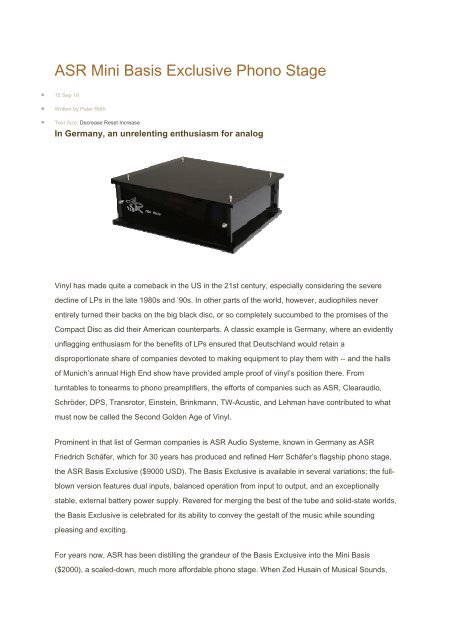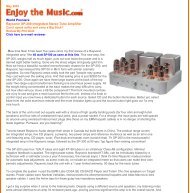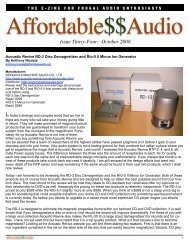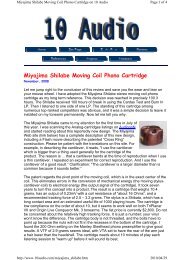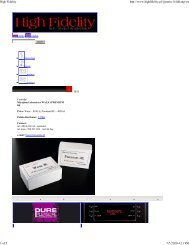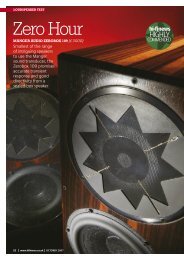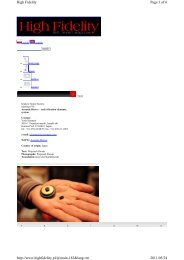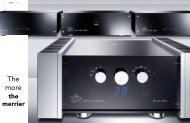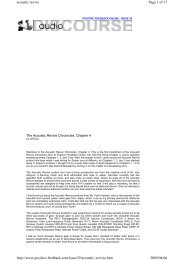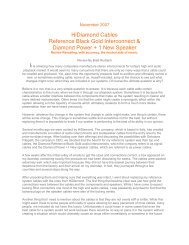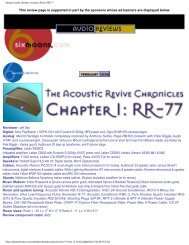ASR Mini Basis Exclusive Phono Stage - Avin Ava Web Site
ASR Mini Basis Exclusive Phono Stage - Avin Ava Web Site
ASR Mini Basis Exclusive Phono Stage - Avin Ava Web Site
- No tags were found...
You also want an ePaper? Increase the reach of your titles
YUMPU automatically turns print PDFs into web optimized ePapers that Google loves.
<strong>ASR</strong> <strong>Mini</strong> <strong>Basis</strong> <strong>Exclusive</strong> <strong>Phono</strong> <strong>Stage</strong>• 15 Sep 10• Written by Peter Roth• Text Size: Decrease Reset IncreaseIn Germany, an unrelenting enthusiasm for analogVinyl has made quite a comeback in the US in the 21st century, especially considering the severedecline of LPs in the late 1980s and ’90s. In other parts of the world, however, audiophiles neverentirely turned their backs on the big black disc, or so completely succumbed to the promises of theCompact Disc as did their American counterparts. A classic example is Germany, where an evidentlyunflagging enthusiasm for the benefits of LPs ensured that Deutschland would retain adisproportionate share of companies devoted to making equipment to play them with -- and the hallsof Munich’s annual High End show have provided ample proof of vinyl’s position there. Fromturntables to tonearms to phono preamplifiers, the efforts of companies such as <strong>ASR</strong>, Clearaudio,Schröder, DPS, Transrotor, Einstein, Brinkmann, TW-Acustic, and Lehman have contributed to whatmust now be called the Second Golden Age of Vinyl.Prominent in that list of German companies is <strong>ASR</strong> Audio Systeme, known in Germany as <strong>ASR</strong>Friedrich Schäfer, which for 30 years has produced and refined Herr Schäfer’s flagship phono stage,the <strong>ASR</strong> <strong>Basis</strong> <strong>Exclusive</strong> ($9000 USD). The <strong>Basis</strong> <strong>Exclusive</strong> is available in several variations; the fullblownversion features dual inputs, balanced operation from input to output, and an exceptionallystable, external battery power supply. Revered for merging the best of the tube and solid-state worlds,the <strong>Basis</strong> <strong>Exclusive</strong> is celebrated for its ability to convey the gestalt of the music while soundingpleasing and exciting.For years now, <strong>ASR</strong> has been distilling the grandeur of the <strong>Basis</strong> <strong>Exclusive</strong> into the <strong>Mini</strong> <strong>Basis</strong>($2000), a scaled-down, much more affordable phono stage. When Zed Husain of Musical Sounds,
<strong>ASR</strong>’s North American distributor, invited me to audition the hot-rod version of the <strong>Mini</strong>, the <strong>Mini</strong> <strong>Basis</strong><strong>Exclusive</strong> ($2900), it was a perfect opportunity to hear just how much of the legendary performance ofthe <strong>ASR</strong> <strong>Basis</strong> <strong>Exclusive</strong> had been trickled down to the crowded $2000-$3000 range.Smallish, stout, squarish, smokyThere was no question about the country of origin of the <strong>ASR</strong> <strong>Mini</strong> <strong>Basis</strong> <strong>Exclusive</strong> (hereafter theMBE): its shipping container had Deutsch written all over it: “Audiosysteme Friedrich Schäfer,”“Vorsicht Zerbrehlich,” and “Produkt aus Deutschland.” For something containing a stout, squarish,but relatively small component measuring 10.5”W x 4.3”H x 12.5”D and weighing just 8.8 pounds, thecardboard box seemed rather large and heavy. The MBE itself was wrapped like a papoose in a largewhite cloth and supported by protective panels of Styrofoam; the box also contained multiple bubblewrapsleeves that cradled everything from the audiophile-grade power cable (which <strong>ASR</strong> has dubbedthe Magic Cord) to a liter of acrylic cleaner. The instruction manual may suffer from someidiosyncrasies of German-to-English translation, but is nevertheless comprehensive andcomprehensible.Having put away my scissors (<strong>ASR</strong> goes overboard with the tape gun), I was able to admire the fitand finish of the MBE, which, while dark, is hardly the usual black box. Precision-cut panes oftransparent acrylic, tinted a dark gray or smoky black, form the four sides, top, and bottom, and give afull view of the inside workings. The top and bottom plates extend beyond the front and back plates,which themselves exceed the dimensions of the side panels. The MBE looks like a miniature ofChicago’s McCormick Place, which used to host the Summer Consumer Electronics Show. A friend atan erstwhile competitor of <strong>ASR</strong>’s assured me that it’s costly to make a chassis of acrylic instead of theusual stainless steel or aluminum, but <strong>ASR</strong>’s choice of material seems motivated by neitheraccounting nor aesthetic priorities. It turns out that acrylic has a significant advantage over metal: itdoesn’t “ring,” but rather has inherent vibration- and resonance-damping properties.
The front panel, devoid of any display, is engraved with the <strong>ASR</strong> logo and the words “<strong>Mini</strong> <strong>Basis</strong><strong>Exclusive</strong>.” Two blue LEDs toward the rear of the enclosure’s interior are clearly visible through theacrylic whenever the unit is powered up. The rear panel is similarly Spartan, with an IEC power inputat the left, and, at center, a ground screw and pairs of RCA connectors for stereo input and output.WBT Nextgen copper or silver connectors and ground screw are optional upgrades ($220 and $365,respectively). Although there is no standby switch -- the MBE draws little power and is best left on atall times -- you can have one fitted to the front panel for an additional $111.Staying on top and going toplessTo access the MBE’s loading and gain functions, its top must be removed -- a simple process ofremoving the four hex-head screws securing the top panel (an Allen wrench is included). Havinglooked under the hoods of more than a few audio components, I appreciated the sensible and preciseinternal layout of the MBE. The workmanship was extremely clean, with accurately applied solder,switches, and other component devices.The power-input module is extensively shielded from the sensitive audio circuitry. The shielded EItransformer -- a type of transformer that provides propagation and containment of the magnetic fieldsuperior to those of common toroidal transformers -- is located at the very front of the internalchamber, again to separate if from the audio circuits. Compact signal paths between inputs andoutputs trace their way through rearward segments of the golden-brown circuit-board material. (<strong>ASR</strong>prefers the mechanical and dielectric characteristics of this more expensive material over theubiquitous green fiberglass.) While the standard <strong>Mini</strong> <strong>Basis</strong> relies on more common, yet fast and lownoiseintegrated circuits from Analog Devices, the MBE’s main upgrade (in addition to the MagicCord) consists of the same, higher-performance AD843SQ devices used in the flagship <strong>Basis</strong><strong>Exclusive</strong>. Schottky rectifiers and Philips power-supply units dominate the forward half of the board.
On the board, at the point closest to the RCA inputs, internal DIP switches make possible a vastvariety of loading options (from 22 to 47k ohms) and gain options (from 30dB to 72dB, in 6dBincrements), to optimize the MBE for use with virtually any cartridge. For my Benz L2, I began with48dB of gain, and maxed out the resistance. After some experimentation with both variables, I endedup with a slightly lower gain setting of 42dB, which gave the best balance of quiet operation anddynamic drive, but I kept the input resistance at 47k ohms.Given what’s inside the MBE, it’s interesting to note which features of the full-blown <strong>Basis</strong> <strong>Exclusive</strong>are not included. As previously noted, the <strong>Basis</strong> <strong>Exclusive</strong>’s fully balanced operation is scaled back tosingle-ended in the MBE. Rather than two individual, fully addressable inputs, only a single inputremains (although at the lower price of the MBE, end-users are less likely to have two turntables or apair of tonearm-and-cartridge combinations, either of which would necessitate dual inputs). Mostobviously, battery operation and its separate power supply are dispensed with in the MBE, while theamount of rectification is significantly scaled back, and the buffering capacity is reduced by almost85% (200,000µF vs. 1,300,000µF).SystemThe <strong>Mini</strong> <strong>Basis</strong> <strong>Exclusive</strong> was coupled to my VPI Scout turntable (with Benz L2 cartridge) for threemonths. Amplification duties were carried out by an Ayre Acoustics KX-R preamplifier and matchingMX-R monoblock amplifiers, driving my Vandersteen 5A speakers. Other than the amps, which reston dedicated HRS platforms, all other equipment resides in a double-wide Harmonic ResolutionSystems MXR rack with M3X shelves. I’ve recently moved this rack, which used to run along one
sidewall; it now stands behind and between the speakers. The rack’s new position slightly degradesthe sound, particularly the soundstaging, but makes more space for my family.I was forced to mix and match cables. Normally, I use only one RCA-terminated interconnect -- a 1mrun of AudioQuest Wild -- between the turntable’s junction box and the phono stage. While I continuedto use the single-ended AQ Wild in this capacity with the MBE, given that the MBE does not output abalanced signal, I needed to reach into my reviewer’s bag of loaner cables -- in this case, for a 1mpair of Cardas’s wonderful Clear RCAs -- to link phono stage and preamp. All other systeminterconnects were various lengths of the balanced version of AQ’s Wild, with the speaker cable beinga 1m, internally biwired set of AQ K2. Power was delivered via AudioQuest NRG100 AC cords and aFurman Sound IT-Reference 20i power conditioner.ListeningThe <strong>Mini</strong> <strong>Basis</strong> <strong>Exclusive</strong> is designed to be left on continuously, so I did. Nevertheless, I was advisedthat it needed at least 100 hours of playing time before it would really show its stuff -- consistent withmy own experience of solid-state gear, especially designs employing dielectrically and mechanicallyrobust circuit-board material, which require significant running in. Unlike a CD player, which can berun on Repeat Play for a week before being placed in a system, a phono stage requires the playing ofmany records to get 100 hours of active use. I set my treasured 45rpm reissues aside andconcentrated on the longest-playing LPs I had. During this period I tried to grin and bear it, as thesound expanded from a shallow, two-dimensional, and somewhat discordant presentation to themuch more full-bodied and musical one detailed below.If you’ve read my recent reviews, you’ll have noted that, to focus on the strengths and weaknesses ofthe product under review, I regularly take for a spin the 45rpm, 180gm reissue of René Leibowitz andthe Royal Philharmonic Orchestra’s The Power of the Orchestra (RCA/Analogue Productions AAPC2659-45). Throughout Mussorgsky’s epic Night on Bare Mountain, a few characteristics of the MBEbecame clear.First and foremost, the MBE communicated the lyrical aspects of music in a pleasing, stress-free way.<strong>ASR</strong> describes this characteristic as a “smooth and relaxing” sound -- the principal element of thefirm’s philosophy of sound. Rather than etch exaggerated leading edges in transients and upperregisters, the MBE let passages develop with a lifelike progression. While many solid-statecomponents try to create an “exciting” sound by applying artificial contrast, eventually such soundsbecome grating, and typically result in listener fatigue. Not so the MBE. Following its break-in period,no listening session, regardless of duration, resulted in any weariness of my ears.
Through the MBE, the RPO’s massed strings avoided any tendency toward the shrill or strident.However, individual string players lost distinction, as the phono stage evinced a propensity to congealthe sound of the section into a single mass. Other instrumental families also lost the nuances of tonaldefinition necessary to identify particular chairs. The lower bass octaves were a bit loose, having lessof the pitch character I prefer. While it benefited lesser recordings, this inclination toward a slightsoftening affected the soundstage, preventing the coalescing of a fully developed three-dimensionalperspective. Luckily, such limitations are all sins of omission, and didn’t impinge on <strong>ASR</strong>’s overridingsonic philosophy.As the MBE’s temperament and overall balance favored the midrange, and smaller rather than largerensembles, I was encouraged to turn to my collection of jazz recordings from the 1950s and ’60s, andtwo John Coltrane records in particular, which I ended up playing repeatedly through the MBE. In thefirst, John Coltrane and Johnny Hartman (LP, Impulse!/Original Recording Group ORG 18), the singerand the tenor saxophonist are backed by pianist McCoy Tyner, bassist Jimmy Garrison, and drummerElvin Jones. Hartman’s sensual, silky-smooth baritone meshes with Coltrane’s passionate, lyrical side-- perfect twin muses to inspire the potencies of the MBE. There was an effortlessness to the soundthat was beguiling, a facility that surely saturated Rudy Van Gelder’s studio on March 7, 1963, whenfive of the album’s six songs were each recorded in a single take. The same instrumentalists, theJohn Coltrane Quartet, sans Hartman, reunited for 1964’s Crescent (LP, Impulse!/Original RecordingsGroup ORG 17). Here Coltrane is at his most romantic, playing tenor saxophone exclusively on thisset of his own compositions. Returning from a period of freeform experimentation, Coltrane devisedmeticulous form and structure for each of these ballads. The lush, swaying dynamic of this album wasperfectly complemented by the MBE.I’d left my Aesthetix Rhea Signature powered on, in standby, for the duration of my listening to theMBE, so comparisons between these phono stages was only a single cable swap away. A few suchsubstitutions laid bare some significant contrasts, the most obvious being the solid-state MBE’sabsence of the drive and energy that the tubed Rhea delivers in spades. There is a spark of life (jumpfactor) to music played through my Aesthetix phono amplifier that is immediately obvious -- a qualityI’ve heard in demonstrations of other top-flight phono stages, such as the Audio Research Reference<strong>Phono</strong> 2, another superlative tube design.It’s not particularly surprising that the $2900 solid-state MBE couldn’t hold a candle to the $7000 RheaSignature, as the more expensive, tubed model excels in so many facets of performance while havingno obvious deficiencies. With regard to the “jump factor” missing from the <strong>ASR</strong>, I have yet to live withany solid-state phono stage that can dish up a full serving of that quality. (However, a new crop ofstate-of-the-art, extremely expensive solid-state phono stages from Vitus Audio and Constellation
Audio are claimed to do just that. Perhaps I’ll have the opportunity to live with one or more of theseexciting, edge-of-the-art devices and report back to you.)A more appropriate comparison product is Ayre Acoustics’ P-5xe ($2500), a phono preamplifier thatserved as my reference for several years before being unseated by the Aesthetix Rhea. Like the <strong>ASR</strong>MBE, the P-5xe is a plug-and-play phono stage designed to remain powered up at all times andfeaturing a single input (which also has a good range of gain and loading options, although not quiteas expansive as the MBE’s). However, like <strong>ASR</strong>’s flagship <strong>Basis</strong> <strong>Exclusive</strong>, the P-5xe offers balancedinputs and fully differential throughput. The Ayre’s jet-black background -- at least a shade or twolower than what’s offered by the MBE or Rhea Signature -- may well be attributable to balancedoperation. While the <strong>ASR</strong> has a more mellow, midrange-oriented perspective, the Ayre is uniquelyevenhanded from top to bottom, and produced a slightly more three-dimensional soundstage --though neither could approach the expansive, rock-solid soundstage laid out by the tubed Rhea.Consistent with its more analytical, intellectual nature, the P-5xe retained more composure duringcomplex, dynamic passages such as orchestral crescendos and harder-edged rock, whereas theMBE was distinguished by its relaxed, lyrical qualities, especially in the midrange. Both of these solidstatecontenders have distinct strengths that will appeal to the preferences of different listeners.Given the similarity of price, I would be remiss not to mention two new phono preamplifiers likely toenhance the competitive fervor in their price range. Legendary circuit designer John Curl has lent histalents to the development of Parasound’s JC 3 solid-state phono stage ($2000). The FosgateSignature ($2500), designed by audio luminary Jim Fosgate for Musical Surroundings, is a tubedalternative that perhaps offers some of the elusive jump factor I so enjoy with my Rhea Signature.Solid German engineeringRather than wholesale changes or flavors of the month, <strong>ASR</strong> focuses on the evolution and perfectionof a limited product line. The <strong>Mini</strong> <strong>Basis</strong> <strong>Exclusive</strong> is a representative product of that approach. Audiocomponents costing from $2000 to $3000 seem to sit squarely at the elbow of the price/performancecurve, where the promise of the high end begins to coalesce into musically satisfying sound, andfollowing which the laws of diminishing returns begin to wreak on one’s cash flow their logarithmiccarnage. The MBE is a solid contender at that elbow. In making sound engineering choices that havedecanted into an attainable “mini” package much of the magic of the big <strong>Basis</strong> <strong>Exclusive</strong>, <strong>ASR</strong> hasproduced yet another example of German engineering excellence. Originating from a firm that, formore than 30 years, has contributed to Germany’s unwavering enthusiasm for vinyl, the <strong>Mini</strong> <strong>Basis</strong><strong>Exclusive</strong> can be expected to provide years of stalwart performance.
Given my preference for the equilibrium offered by the slightly less expensive and fully balanced AyreP5-xe, as well as the design pedigree behind the similarly priced entrants from Parasound andFosgate, my recommendation of the <strong>ASR</strong> <strong>Mini</strong> <strong>Basis</strong> <strong>Exclusive</strong> is qualified. I wouldn’t buy any of thesephono stages without auditioning at least several of them, as the diversity of one’s vinyl library andtaste in sound will make all the difference in one’s ultimate selection. For those who settle on theMBE, central to that choice will almost certainly be its refined, musical midrange.. . . Peter Rothpeter@soundstagenetwork.com<strong>ASR</strong> <strong>Mini</strong> <strong>Basis</strong> <strong>Exclusive</strong> <strong>Phono</strong> <strong>Stage</strong>Price: $2900 USD as reviewed.Warranty: Two years parts and labor.<strong>ASR</strong> AudiosystemeHohe Strasse 700, Haus 5AHerborn D-35745GermanyPhone: +49 (27 72) 4 29 05Fax: +49 (27 72) 4 04 88E-mail: info@asraudio.de<strong>Web</strong>site: www.asraudio.de<strong>Avin</strong> <strong>Ava</strong> Arta Co.<strong>ASR</strong> AudiosystemeIRANTel: +98 21 22945596E‐mail: info@avinava.com<strong>Web</strong> <strong>Site</strong>: www.avinava.com


